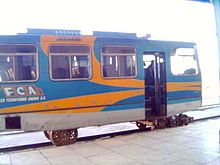Empresa Ferroviaria Andina
Coordinates: 17 ° 30 ′ 0 ″ S , 67 ° 42 ′ 0 ″ W Empresa Ferroviaria Andina SA is a railway company in Bolivia . The company operates2,261 km of railroad lines in metergaugein the Bolivian highlands ( Altiplano )and offers both passenger and freight transport services. The company is based in La Paz in the Andes highlands.
Route network and traffic volume
The most important route for passenger transport is the route from Oruro via Uyuni to Villazón . The two trains Expresso del sur and Wara wara del sur run on this during the night .
Once a week there is another connection from Uyuni to the Chilean border near Avaroa . The second route to Chile, reopened in 2013, which leads Arica-La Paz ( Ferrocarril Arica a La Paz, FCALP), with occasional passenger service, to the border stations Visviri in Chile and Charaña in Bolivia.
Various routes are used exclusively for the transport of goods, especially for the removal of ore from the mines. This mainly includes the stretch from Río Mulato to Potosí .
Many lines have been closed since privatization. These include the Potosí - Sucre , Sucre - Tarabuco , Aiquile - Cochabamba , Cochabamba - Oruro , Oruro - La Paz and La Paz - Guaqui routes .
The La Paz-Guaqui line was repaired in 2007 and a single train ran at the opening with President Evo Morales.
Vehicles used
Trains hauled by a locomotive
The two connections Expresso del sur and Wara wara del sur between Oruro and Villazón as well as the connection Uyuni - Avaroa are operated by trains hauled by diesel locomotives.
Locomotive-hauled trains are also used to transport goods.
Ferrobus
On the routes Cochabamba - Aiquile and Sucre - Potosi were Ferrobuses used. On these routes, areas without good road connections were opened up by local transport.
The buses used here were originally not designed for rail use, but for the road. They were retrofitted with a rail chassis. The drive train (engine and transmission) was retained during the conversion. The handling of a Ferrobus is the same as that of a people carrier, except that the steering wheel has been removed as it is not needed.
A converted FCA Ferrobus offered space for around 20-30 people.
With wages as is common in South America, converting a street bus is cheaper than buying new rail vehicles.
Ferrobuses were often poorly motorized due to their long history and the route to be traveled was in poor to miserable condition. In Europe this would be described as not passable .
The Sucre - Potosí route , which ran through a scenic area and had loop loops like on Alpine railway lines (but without a spiral tunnel), was originally reopened in 2005 as a means of tourist transport. Due to the two to three times longer travel time than by bus or car, however, hardly a tourist can be found on the route. The travel agencies in Bolivia were often not even aware of the rail bus option.
See also
Web links
- Homepage of Empresa Ferroviaria Andina SA (Spanish)
- FCA passenger transport and route network (Spanish)
